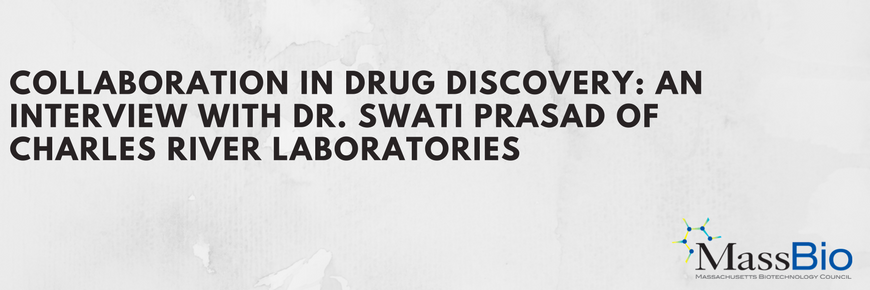
Why are pharmaceutical companies focusing more on external collaboration for innovative ideas? This is one of many questions being addressed at the 2017 ASAP BioPharma Conference, “Accelerating Life Science Collaborations: Better Partnering, Better Outcomes,” to be held Sept. 13-15 at the Royal Sonesta Boston, Cambridge, Mass., during the panel discussion “Strategic Perspectives on Emerging Drug Discovery Alliance Models.” It’s also a central theme in a recently published white paper, “Filling the Drug Discovery Abyss: Novel business models to push through the Valley of Death,” http://bit.ly/2kSvlnt that appeared in the winter issue of Drug Discovery World. A companion ASAP Media article can be found in the ASAP E-SAM Plus.
Appearing in both forums is Dr. Swati Prasad, senior manager of business development and scientific alliances at Charles River Laboratories in Wilmington, Mass. Dr. Prasad manages drug discovery alliances and strategic partnerships to increase revenues, penetrate markets, and strengthen drug discovery portfolios at Charles River Laboratories. She previously worked with AstraZeneca Pharmaceuticals. Having just returned from India, Dr. Prasad took time out from her very busy day to discuss with me the increasing shift toward collaboration in drug discovery and development.
The high cost of drug development, regulatory “red tape,” and scientific challenges are placing pharmaceuticals under tremendous pressure to adapt. External collaboration is becoming increasingly attractive to avert a decline in pharmaceutical research and development productivity, says Dr. Prasad. Pharmaceuticals are quickly finding out that partnering can accelerate essential innovation and improved revenues, as well as streamline the R&D process.
There is a gap period in early drug development that has been coined the “Valley of Death,” where early innovation is typically incubated, explains Prasad. “This is the rocky terrain that separates upstream research on promising genes, proteins, and biological pathways from downstream drug candidates. These alliances are becoming an integral part of the R&D approach because they contribute to building key scientific evidence for drug development programs for clinical success.”
CROs are critical to filling the gap because they have the infrastructure to handle work that used to belong with science laboratories within Big Pharma, she continues. Many CRO workers started out in biopharma and consequently are highly skilled. That makes them indispensable because of their deep clinical knowledge.
“From the CRO’s perspective, the benefit to our partners is not just providing external validation of their critical data but also acting as consultants for our partners and providing inputs on how to de-risk their scientific and proof-of-concept programs,” she adds. “Our academic partners are quite interested in learning from our experiences on how a particular candidate can be developed, and they use this information to build their drug development plans.”
Charles River Laboratories also has an integrated drug discovery (IDD) team that has delivered more than 75 candidates to various biopharmaceutical partners. The IDD team engages in a wide range of therapeutic areas, internal disciplines, and expertise, including in vitro biology, synthetic and medicinal chemistry, structural biology, in vivo pharmacology, and subsequently, pharmaceutics and process chemistry.
The challenge is getting academic researchers to think like entrepreneurs, Prasad says. It’s a major shift for them in thinking because they typically are not comfortable with product development when drug development moves downstream, requiring more regulatory requirements, testing, and safety assessments.
Key to this shift are the emerging new business models with non-traditional, venture-type arrangements to help R&D costs and share associated risks in scientific programs. Several are mentioned in the white paper, including BioMotiv, a for-profit accelerator that is part of the Harrington Project. The project is a $300 million international drug development effort launched by University Hospitals Cleveland Medical Center to advance discoveries into new medicines that are obtained from academic research and non-governmental organizations. BioMotiv provides an increasingly important connection between academic projects and late-stage commercialization partners.
A second resource is the UK-based Milner Therapeutics Institute, which was launched two years ago with a £5 million (about US$6.5 million) donation from Jonathan Milner, the co-founder of the antibody producer Abcam. The academic-based drug discovery labs are scheduled to open in September 2018, on the Cambridge Biomedical Campus in Cambridge, England. The Institute already has an active outreach program that involves a consortium of seven pharmaceutical companies, three academic institutions, and 36 affiliated partner companies—including Charles River.
For more information on this topic, go to http://bit.ly/2kSvlnt for the white paper that appeared in the winter issue of Drug Discovery World written by Dr. Prasad, Dr. McOsker, vice president technical operations for BioMotiv; Professor Kathryn Chapman, executive manager of Milner Therapeutics Institute; Dr. Michael Foley, Sanders director of the Tri-Institutional Therapeutics Discovery Institute. Also, http://www.asapbiopharma.org/17/bio17sessions.html for a description of the ASAP BioPharma Conference session “Strategic Perspectives on Emerging Drug Discovery Alliance Models,” in which Dr. Prasad is a panel member.